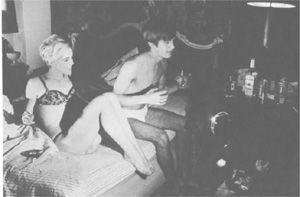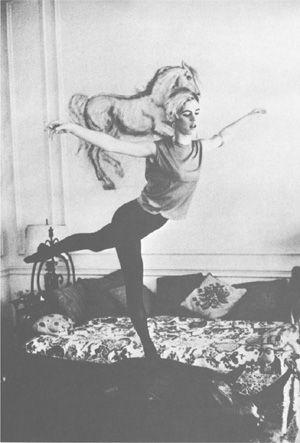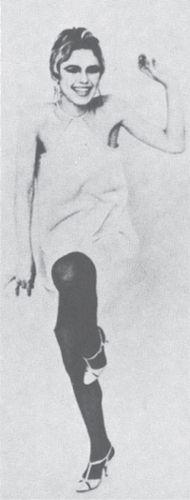Edie (37 page)
Authors: Jean Stein


Edie and Gino Piserchio,
Beauty Part II,
July, 1965
There was a third character in the film—he was an older man from the Warhol entourage, Chuck Wein, who was sort of Edie’s guru at that point—and the concept here, I thought, was the genius of the whole project. He was to be seen in the foreground of the film, just a shoulder showing in a lower corner of the frame, or the side of his head—the form of a man sitting on a chair in the shadows and watching the bed in front of him, very much the set-up of an
exhibición
in some cheap Havana hotel in the pre-Castro days.
But he wasn’t really so much a voyeur as a sort of inquisitor. I remember his voice—nagging and supercilious and quite grating, which may have been the fault of the sound track, too. A lot of the questions, rather searching and personal, were about her family and her father. On the bed Edie was torn between reacting to the advances of the boy next to her and wanting to respond to these questions and comments put to her by the man in the shadows. Sometimes her head would bend and she would nuzzle the boy or taste him in a sort of distracted way. I remember one of the man’s commands to her was to taste “the brown sweat,” but then her head would come up, like an animal suddenly alert at the edge of a waterhole, and she’d stare across the bed at her inquisitor in the shadows. I remember it as being very dramatic—at least, compared to the other stuff we had seen—and all the more so because it seemed so real, an actual slice of life, which of course it was.
I couldn’t get the film out of my mind. I had known Edie during that period. I went to Sunday lunch once to her grandmother de Forest’s. Edie had on a lipstick color that was silvery and moist and I thought it made her look wan and ill. We always had an easy and civilized time, though. But I remember that evening when Peter and I watched the film for the first time—that when it finished, the end of the film flapping as it turned on the take-up reel, I turned to Peter and I said incredulously, “I don’t know that girl. I don’t know anything about her at all.”
RENÉ RICARD
It was the high paint in Edie’s career. She was the girl on fire with the silver hair close to her head, the eyes, the Viceroy in her fingers, the sleeves rolled up, those legs, yoicks! . . . all you saw was her!
PATTI SMITH
The first time I saw Edie was in
Vogue
magazine in 1965. I was seventeen or eighteen then. You have to understand where I came from. living in south Jersey, you get connected with the pulse beat of what’s going on through what you read in magazines. Not even through records.
Vogue
magazine was my whole consciousness. I never saw people. I never went to a concert. It was all image. In one issue of
Vogue
it was Youthquaker people they were talking about. It had a picture of Edie on a bed in a ballet pose. She was like a thin man in black leotards and a sort of boat-necked sweater, white hair, and behind her a little white horse drawn on the wall. She was such a strong image that I thought, That’s it.” It represented everything to me . . . radiating intelligence, speed, being connected with the moment.

Edie as a “Youthquaker,”
Vogue,
August, 1965
Vogue,
August 1965
People Are Talking About
. . .
YOUTHQUAKERS
. . . Edith Sedgwick, twenty-two, white-haired with anthracite-black eyes and legs to swoon over, who stars in Andy Warhol’s underground movies. ‘It’s like watching a Henry Moore sculpture out of focus,” said Edith Sedgwick, who toyed with the movie name Mazda Isphahan for Poor
Little Rich Girl.
With Pop artist Andy Warhol on camera, undergrounds roll out like crepes:
Vinyl
is in the can;
Vacuum
about to turn “when we find a pure white kitchen.”
Rich
Girl was made in Miss Sedgwick’s apartment, where she is shown here arabesquing on her leather rhino to a record of The Kinks. . . . In Paris Warhol’s gang startled the dancers at Chez Castel by appearing with fifteen rabbits and Edie Sedgwick in a black leotard and a white mink coat. In her deep, campy voice, strained through smoke and Boston, she said: “Ifs all I have to wear.”
PATTI SMITH
I would read about these discotheques. I would come all the way up to New York to loiter in front of a discotheque, watch people go into Arthur’s or Steve Paul’s The Scene. For me it was like seeing Hollywood. I saw Edie dance once. It was the big moment of my life. I think I said I had to use the bathroom, and some weak guy at the discotheque door let me through. I remember I had on a green wool mini-skirt. For New Jersey I looked pretty hot, but I didn’t look so hot there. What I remember most of all were their earrings. I thought they were really neat dancers but unusual. We didn’t dance like that in New Jersey. I was brought up in a really black area and we were really great dancers. I thought they danced like weird chickens. They just didn’t have that fluid nigger grace that my friends and I possessed. Everything was angles. Everybody was skinny, and it was elbows and angles and knees and earrings. It wasn’t a question of my wanting to be them. I just liked that they existed so I could look at them.
ROY LICHTENSTEIN
My wife, Dorothy, and I went to a Halloween costume party given by the painter adele Weber, dressed As Andy Warhol and Edie. Andy looked somewhat different then—leather jacket, blue jeans, funny sunglasses, and funny shoes that were all broken up . . . silver paint on them. Easy to imitate. I sprayed my hair with silver paint and I powdered my face to look very pale. When people said anything to me at the party, I said, “Oh, wow I” or “How glamorous!” Even though Andy can be unusually articulate, I reduced his repertoire to those two expressions. Dorothy wore hot pants and
very high heels and put on a lot of silver glitter. She had short hair like Edie’s. Andy does exactly what I don’t do.
He
was his art. His studio was his art. Edie was part of his art, and a lot of other people. I was an old-fashioned artist compared with him. When I looked at Andy, I looked at him as a tourist would, I guess . . . with wonderment. How glamorous. How strange.
VICTOR NAVASKY
I was on a David Susskind panel on his television show. “Who’s In and Who’s Out” was the topic for the night, and Edie as Girl of the Year was on it, along with Gloria Steinem, Russell Baker, and I forget who else. Susskind began the show by making fun of Edie. “Why do you dress like that? Why do you . . . ?” And she was answering half defensively and half in a Warhol way. Her whole life was a media event.
New York
World-Telegram,
August 18,1965
Gotham-Go-Round, Joseph X. Dever, Society Editor
EDIE SEDGWICK AND ANDY WARHOL,
ROYAL MEMBERS OF UNDERGROUND MOVIES
Chez Catharsis: At a low decibel point amid the deafening sound of the Executives trio last night at the Scene, we shouted into the ear of Edie Sedgwick, silver-topped queen of the underground movies: “Where is the
real
Edie Sedgwick—home with a book?” The bob-haired, 20-year-old heiress from California looked to see if we were serious, then shouted back: “The real Edie is where the action is. Fast cars, fast horses, and people doing things!” With that, she watusied away, her trademark leotards lost in a swirl of hip-huggers, tight blue jeans, Pucci slacks, and little-girl mod dresses. That swinging catacomb on W. 46th St., the Scene definitely was where the action was last night. . . .
ANDY WARHOL
She was always making fun of the kind of clothes she wore—saying that not wearing underwear, and things like that, was her way of showing that her family didn’t give her any money. Actually, she invented all those new clothes and stuff. She always looked so good. Edie was a beauty, gee I
WENDY VANDEN HEUVEL
She came to a party at my mother’s. The maid said, “Can I take your coat?” She said, “No, I don’t think so. I’m a little cold.” Later Edie told me the real reason she didn’t want to take her coat off was that she wasn’t wearing any clothes under it.
I was about five years old at the time. I thought it was funny that she would come to a party with no clothes on, just a coat. We had funny conversations. I would say “Hi,” and she would say “Hi,” and then I would say “Hi,” and we’d just keep on saying “Hi,” “Hi,” “Hi,” to each other. It seemed like she had so many friends, but when you really looked at her face, it was like she never had
any
friends.
ANDY WARHOL
She always wanted to leave. Even if a party was good, she wanted to leave. It’s the way they work now hi St. Moritz: I mean, people who spend fortunes to have parties can’t wait until they’re over so they can go somewhere else. I don’t understand that. Can’t wait to go . . . and there’s no place to go. These people in big, expensive cars can’t wait to get to the next party . . . and there’s no next party. They just get up and leave. If s really funny. But Edie was like that. She just couldn’t wait to get to the next place.
One night, when the parties were over, I guess she didn’t want to sleep with somebody, so she asked me to share a room with her. She always had to have her glass of hot milk and a cigarette in one hand. In her sleep her hands kept crawling; they couldn’t sleep. I couldn’t keep my eyes off them. She kept scratching with them. Perhaps she just had bad dreams. . . . I don’t know, it was really sad.
New York
World-Telegram
September 14,1965
Gotham-Go-Bound, Joseph X. Dever
. . . Clip-coiffed Edie Sedgwick upstaged
The Vampires
on screen at the Lincoln Center film festival last night as she swept in on the arm of pop artist Andy Warhol. Edie’s outfit included her usual black leotard plus a trailing black ostrich-plumed cape like a camp version of Mme. Dracula. . . .
Life,
November 26,1965
FASHION:
The Girl with the Black Tights
This cropped-mop girl with the eloquent legs is doing more for black tights than anybody since Hamlet.
the Black Tights

T
hough she stI’ll goes for an occasional T-shirt like the one at center by Cole ($4), Edie is now on a dress kick. The pale dress above, with halter neckline, is made of wool knit by Rudi Gernreich ($35). The checked silk print at far right, also by Gernreich, has a turtleneck that ties over the head ($155).
